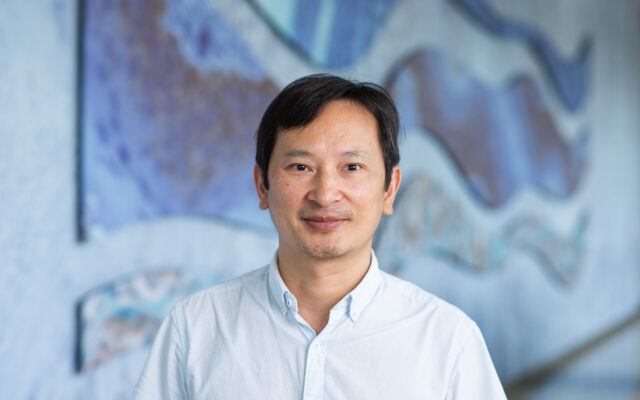Hormel Institute scientists publish research in two high-impact journals

The team of Bin Liu, PhD, Associate Professor at The Hormel Institute, University of Minnesota, recently published two high-impact journal articles offering new insights on the mechanisms of transcription activation in bacteria, a process essential to many cell functions. Dmytro Kompaniiets, PhD, and Dong Wang, PhD, are listed as first authors of these publications. More comprehensive understanding of this pivotal process has the potential to benefit a broad range of future research, including for projects aimed at developing more effective antimicrobial treatment strategies for patients, as well as other biotechnological
applications.
The first article, entitled “Structural basis for transcription activation by the nitrate-responsive regulator NarL,” appears in Nucleic Acids Research (Oxford University Press) and describes the researchers’ findings after using cryo-EM to closely analyze the transcription activation mechanisms specifically related to the Escherichia coli (E. coli) general transcription factor known as NarL.
The second article, an invited review entitled “Structure and molecular mechanisms of bacterial transcription activation,” appears in Trends in Microbiology (Cell Press) and provides a comprehensive overview of both newly discovered and already-known mechanisms of transcription activation in bacteria.
Transcription is the first and essential step in the process of gene expression, which turnsgenetic information into a particular cell function. The process is also involved in antibiotic resistance in bacteria, making it crucial in the effort to understand and develop protections against in order to safeguard public health. During transcription, the information encoded in a gene is used to create RNA molecules. Eventually, these RNA molecules will either carry out certain cell processes themselves, or they’ll create the necessary proteins to do so.
Significant advancements in the field of structural biology, such as with cryo-electron microscopy (cryo-EM), have allowed researchers to study high-resolution molecular structures more closely than ever before. These studies now show that the transcription activation process in different bacteria can get a lot more complicated than was previously understood.
“Cryo-EM is one of the main tools that helps to translate a broad term ‘proteins’ into highly specific structural data,” said Dr. Liu. “Data sets of the 2D movies collected from the frozen sample are processed by specific software and used to generate high-resolution 3D structures that provide a new understanding of the molecular mechanisms happening within the cell.”
In recent years, a number of new high-resolution structures of various transcription activation complexes (TACs) have been published, yielding new insights that significantly impact current understanding of the transcription activation process. These developments have revealed a diverse array of activation mechanisms among different types of transcription factors, and even different functions specific to some species of bacteria.
NarL, for example, has been recognized as a significant general transcription factor for several decades, but exactly how it activates transcription was unclear. The Nucleic Acids Research paper presents the long-awaited intact NarL TAC structure at a near-atomic resolution (3.2Å). The analysis revealed unusual, potentially novel mechanism characteristics for NarL and other related proteins.
To better compensate for such complexity and diversity moving forward, the Trends review proposes a framework for a structure-based classification system for TACs and their combinations.
“The current classification of transcription activation mechanisms is insufficient for the task of clearly defining and dividing recently discovered mechanisms into specific groups,” said Dr. Liu. “The classification proposed in our publication will improve our understanding of transcription activation mechanisms at a basic structural level and guide or provide new insights into possible future research directions.”
Many fundamental research questions are tied to the transcription activation process, such as in the areas of bacterial multidrug resistance, stress responses, and cells’ survival mechanisms. It is anticipated the findings here will have a broad impact on the general fields of gene regulation, cryo-EM, transcription, and biotechnology.
The projects are co-led by Dr. Bin Liu at The Hormel Institute and Dr. Yangbo Hu at the Chinese
Academy of Science.
You Might Also Like



